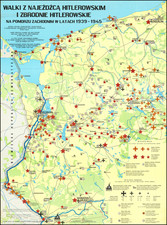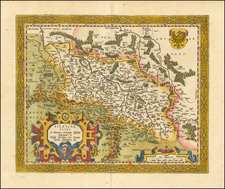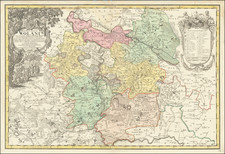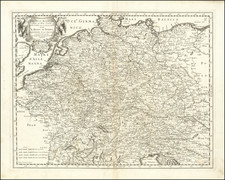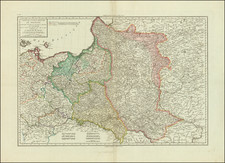Monumental Wall Map of Poland
This exceptional map of Poland, divided into provinces and palatinates and further subdivided into districts, was created by Giovanni-Antonio Rizzi-Zannoni in 1772. It consists of 24 sheets, each dissected, mounted on linen, and folding into three contemporary cases, and is accompanied by a key sheet and engraved dedication letter.
The map was constructed using numerous surveys and observations, and it showcases Rizzi-Zannoni's impressive capacity for large-scale cartography. It is the only large scale map of Poland from this period showing future Belarusian lands in detail and drawn to scale, and includes annotations in Polish, French, and Ottoman Turkish (لسان عثمانى Lisân-ı Osmânî )
The upper left corner of this map features a fine example of the earliest obtainable city plan of Warsaw, engraved by Chalmandrier for Giovanni Antonio Rizzi Zannoni in 1772. This plan is based upon the 4-sheet plan of Warsaw by Pierre Ricaud de Tirregaille, entitled "Plan de la ville de Varsovie: dedie a S. M. Auguste III Roi de Pologne, Electeur de Saxe etc. etc.", first published in 1762. Rizzi Zannoni's plan of Warsaw was published just before the country's first partition (dismemberment) between Prussia, Russia, and Austria. The town plan is surrounded by 17 vignettes of important buildings, with the lower section featuring a fine large panoramic view of the city taken from the east side of the Wisla. A numbered key identifies 82 important landmarks, and the title cartouche is surmounted by a coat of arms and white eagle, dedicated to Count Michal Wielhorski.
Pierre Ricaud de Tirregaille was a French architect and engineer who came to Poland in 1752. He worked as a civil architect, surveyor, and army engineer, eventually attaining the rank of lieutenant colonel in the Polish armed forces. In 1758 and 1759, Tirregaille worked for the "Komisja Brukowa" or Cobblestone Commission, which was responsible for paving the streets of Warsaw and creating a modern sewer system. In 1762, Crown Marshal Franciszek Bielinski commissioned Tirregaille to prepare a detailed plan of the city of Warsaw, resulting in the creation of the first map of Warsaw based on a scientific survey. Rizzi Zannoni's plan is dedicated to Count Michal Wielhorski, a Polish noble, official, politician, diplomat, and writer. This map was prepared during Wielhorski's stay in Paris and reflects the prevailing French Enlightenment sympathies toward Poland's efforts to preserve its independent republic status.
The map is dedicated to Prince Prusse Vindes Joseph Alexandre Jablonowski, a Knight of the Order of the Holy Spirit, of St. Michael, and of St. Hubert, and a Palatine of Nowogrod. Jablonowski was a member of the Royal Academies of Sciences and Fine Arts of Paris and of the foremost Literary Societies of Europe. According to Rizzi-Zannoni's dedication, the map was created as a result of Jablonowski's dedication to the arts and his family's long-standing association with the glory of arms.
The dedication sheet includes a heartfelt letter from Rizzi-Zannoni to Jablonowski, expressing his gratitude and acknowledging the prince's significant contributions to the map's creation. Jablonowski himself had traveled through many of the regions depicted on the map, accompanied by the best geographers who took measurements under his watchful eye.
The legend provides detailed explanations of various symbols used throughout the map, such as cities, towns, castles, and geographical features. An elaborate cartouche can be found on the lower left sheet.
This map is a testament to Rizzi-Zannoni's skill and dedication, as well as to Jablonowski's passion for geography and his commitment to providing an accurate and comprehensive map of Poland for his nation.











![[Southern Poland] Polonia Propria, tanquam Regni Polonici Provincia primaria, in Poloniam Maiorem sive inferiorem atque Minorem, sive Superiorem divisa, ut et in suos Palatinatus Sataque Districtus Subsidiis ad normam legitimae Projectionis . . . 1772](https://storage.googleapis.com/raremaps/img/small/77465.jpg)
